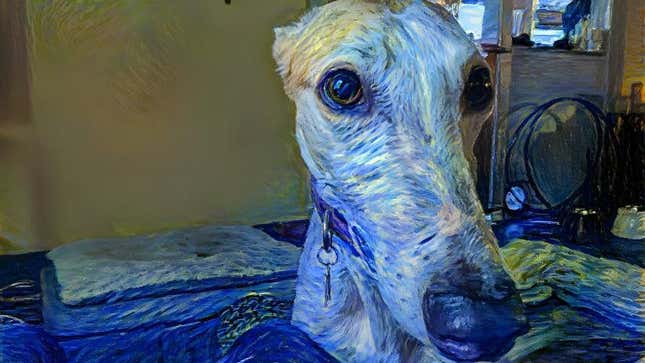
You now can’t go anywhere without finding some company shouting from the rooftops about generative AI. While the folks at Snapchat and Discord are busy slapping OpenAI’s ChatGPT into their systems, companies like Shutterstock and Adobe think more people would be interested in using a AI image generator when grabbing a stock image. Don’t mind Getty Images though, they have some pretty negative thoughts about AI.
Maybe you’re trying to see what the fuss is about, or perhaps you just want to create something new or cool, but AI image generators remains an interesting bit of tech, especially when used for fun and not profit. Leaving the question of whether AI-generated pictures are legitimate “art” by the wayside, the best system-produced images are more than just ways to create strange nightmare depictions of celebrities portrayed in various art styles. At the same time, it’s not enough for the digital artiste to vaguely offer an impressionistic, oddly shaped “interpretation” of users’ original pictures or prompts.
There’s a middle ground amid all this crush between technology and art that even the most untrained in the arts of brush on canvas can comprehend. What can inspire us? What can intrigue us? That is what AI image generators have the capacity to do.
So we turn to the free AI art generators, or at least the ones that offer free trial options. There’s systems like Jasper, which released its AI art generator Jan. 17. But while its program seems interesting, there’s no way to get a free trial without inputting credit card details where it will automatically charge you after five days. Sorry, but that’s not free.
For the purpose of these rankings, I wanted to ignore the hubbub around total terabytes of training images, but the total time it takes to create each image, their standard free resolution, and usability are all taken into account. To best rank each program, I gave them all the same, rather esoteric, text prompts based on some books I’ve recently read. Those books include:
Under the Pendulum Sun by Jeanette Ng
Prompt: “A man and woman stand under a pendulum sun in the heart of Arcadia.”
The Dispossessed by Ursula K. LeGuin
Prompt: “A lone mathematician stands on a dusty planet owning nothing.”
A Memory Called Empire by Arkady Martine
Prompt: “A foreign woman struggles alone against the machinations of a cosmic empire.”
There are several image generators which require photos instead of text prompts. As much as I would like to keep it consistent, I want to be inclusive of different systems rather than exclude them. For the image generating platforms that don’t allow for text prompts, I used the same image for each one:
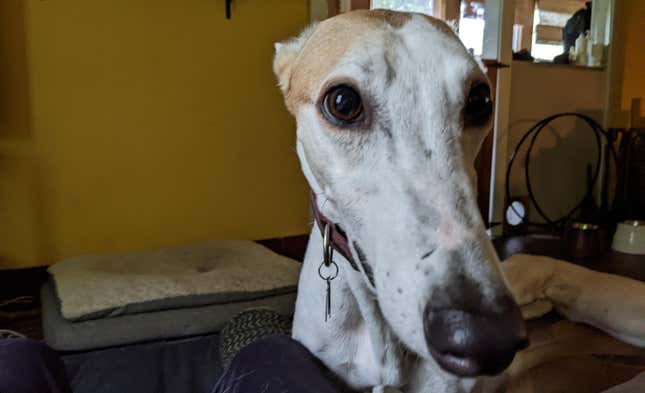
Some systems, like ArtBreeder’s “collager” model, ask users to be a little more creative when generating images by formatting shapes and images into new art. In my own tests I found it did not create art with any meaningful quality, so I did not include that feature in the list. Artbreeder’s “Splicer” model kept deforming the image to the point it was unusable, and I quickly used up its three upload slots for the free version. Sorry, but no dice, Artbreeder.
Also, other systems like MyHeritage’s AI Time Machine sure is neat, but for one, it doesn’t like it when you put in dog pics. More importantly, it requires you invest put in a credit card to sign up for a free trial. That doesn’t meet my definition of “free.”
I’m no art critic by any imagination, but at least I can tell whether AI generated art actually attempted to depict a prompt in a way that’s not derivative or that relies upon copying and replicating art found on the internet.
To be honest, I’m pleasantly surprised by some of the results from a few of the more popular free art generators. Let’s take a look, shall we?
Want to know more about AI, chatbots, and the future of machine learning? Check out our full coverage of artificial intelligence, or browse our guides on How to Use ChatGPT and Everything We Know About the OpenAI chatbot.

The first text-to-video AI generator to catch the internet’s attention, ModelScope, was released in March 2023. The AI video generator is rudimentary, producing only 2-second clips that feature odd distortions much like early AI image generators. Many of its videos also bear the Shutterstock logo, hinting at where it gathers its training data from.
From Gizmodo’s test drive of ModelScope:
The AI text to video system called ModelScope was released March 18th and already caused some buzz for its occasionally awkward and often insane 2-second video clips. The DAMO Vision Intelligence Lab, a research division of e-commerce giant Alibaba, created the system as a kind of public test case. The system uses a pretty basic diffusion model to create its videos, according to the company’s page describing its AI model.
SLIDE #217. Runway Gen-2

Runway teased its Gen-2 AI video generator in late March, offering several 3-second clips—an eye, a mountain, an apartment. The text-to-video AI is not publicly available as of April 1, but it offers tantalizing possibilities. The Gen-1 version, a video-to-video model, can create and transform existing videos based on text prompts or reference images.
From Gizmodo’s comparison of Runway Gen-2 to ModelScope:
Gen-1 could transform a simple render of a stick figure swimming into a scuba diver, or turn a man walking on the street into a claymation nightmare with a generated overlay. Gen-2 is supposed to be the next big step up, allowing users to create 3-second videos from scratch based on simple text prompts.
Since February, the relatively small 45-person team at Runway has been known for its online video editing tools, including its video-to-video Gen-1 AI model that could create and transform existing videos based on text prompts or reference images. Gen-1 could transform a simple render of a stick figure swimming into a scuba diver, or turn a man walking on the street into a claymation nightmare with a generated overlay. Gen-2 is supposed to be the next big step up, allowing users to create 3-second videos from scratch based on simple text prompts. While the company has not let anybody get their hands on it yet, the company shared a few clips based on prompts like “a close up of an eye” and “an aerial shot of a mountain landscape.”

Oh boy, turn your image into NFT “art,” how grand a design. Well, beyond attempts to monetize the poor greyhound, let’s see what Fotor can do to make Skip a little more painterly.
Using the program’s GoArt creator, there’s honestly nothing here that I haven’t already seen from a Photoshop filter. Though the program is relatively easy to use, I don’t see any real fun to be had making an image a little more sketch-like. The program does have a neat little photo editor, but if you want an image without a watermark you’ll have to pay, but really you shouldn’t expect anything less. There are better, free programs available online if that’s all you’re looking for.

Using Replicate’s standard vqgan engine on Pixray’s free site, I created two very confused images and one that could be construed as a modern art interpretation of what a desert looks like. It’s an older system and is still using features from generative adversarial network algorithms. That would be just one factor, but the images take a fair bit of time to process and even then their resolution is incredibly tiny.
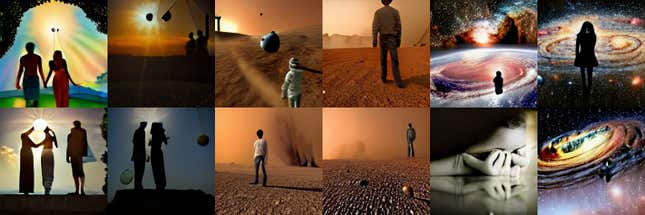
DeepAI’s rather simple and rudimentary AI generator doesn’t have a lot of bells and whistles, and despite all that it… doesn’t have much else going for it anyway. The text to image API system simply doesn’t have the bells and whistles more updated systems have. The images are more collages of images found on the internet than any real attempt at creating something “new.”
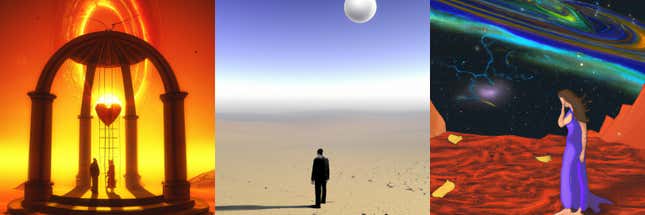
Unlike some of its stock service contemporaries, Shutterstock has dived head first into AI generated content. The company started facilitating sale of AI content late last year and inked a deal with DALL-E creator OpenAI. To access the generator, users need to sign up for Shutterstock. While you can use the service to download images, those without a subscription still need to pay for each generated image, so it’s hard to call it truly “free.” So despite the images being somewhat better quality than others, that’s why it’s ending higher up on the list.
Earlier this year, Shutterstock released its DALL-E 2-based AI image generator. The service generates four images at about 500×500 pixel size, which is pretty sizable compared to some of its competing platforms. Users can set the output between five separate “styles” to make the generated image look “3D” or more like a digital photo.
Like all the other generators in this list, I used the most basic output possible, and I received a few surprising results. The system generated several rather interesting Under the Pendulum Sun inspired images, though like all AI image generators it clearly has problems with straight lines and latticework. The system took obvious inspiration from picture book style for its multiple renditions of A Memory Called Empire. It could almost be considered artistic, save for the misplaced arm and awkward shadow running along the woman’s back.
Another consideration is how Shutterstock claims it is using contributor’s photos and images to train the AI. The company has promised to compensate contributors whose images train the AI through a so-called “Contributor Fund.” Image contributors receive a “share” of the pie based on how many images they’ve uploaded to the site.
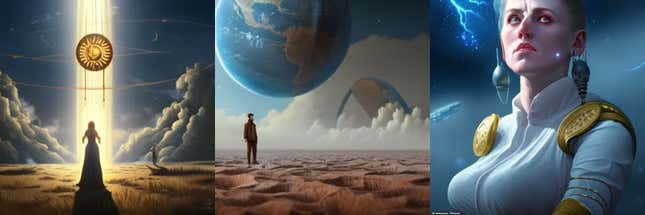
Hotpot.ai’s art generator is a pretty rudimentary program, but in the time since I first tried the program, it has gotten much more capable. The company is also advertising different features, like tools to remove objects and backgrounds from photos, though those do indeed cost money.
The whole “free” aspect is where Hotpot hurts the most. Creating small, thumbnail-sized images is free, but doing anything more, including resizing or allowing “commercial use” costs a subscription. I’m surprised by the quality of the images generated, especially how each image definitely has a lot of classic Sci-Fi and fantasy feel to them, but the limitations on the free versions hurt it the most.

Runway ML was one of the two startups that helped give us Stable Diffusion, and its free text-to-image service has the same quality as the earlier open source versions of the software. As Runway continues to get millions in investment funding, according to Forbes, the company has moved on to AI-based video editing tools, image expansion services, along with the rest of its suite of customizable AI tools, most of which require payment to get the most out of.
But as for this free service, users get just 25 images to start before being asked to upgrade, which isn’t so great compared to some others. The actual quality of images when using these non-specific prompts leaves quite a lot to be desired. Also, like Stable Diffusion Runway has a fascination with fake text meant to resemble a book cover.

The Dream Studio beta AI art generator is free, and it has a lot of bells and whistles other AI art generators don’t have, like the ability to scale the width and height of the image while telling it how close you want the image to be to your prompt. It’s developed by Stability AI, which recently released a much more popular AI art generator (click through to find out more of Stable Diffusion).
The system is also surprisingly fast, just by the examples above you can see the AI isn’t afraid to mix and match art styles on a whim.
Unfortunately, using my prompts resulted in some interesting renditions, but a few weird and strangely derivative images as well. Several times when I used the A Memory Called Empire prompt I received images with broken text in no human language, almost like an alien book cover. It’s a sign that the system really wants me to give it more information, to tell it to rip off one particular artist or another. It does so much better when you give it the name of an artist to copy off of, but it’s similar to our next AI art generator in that regard.
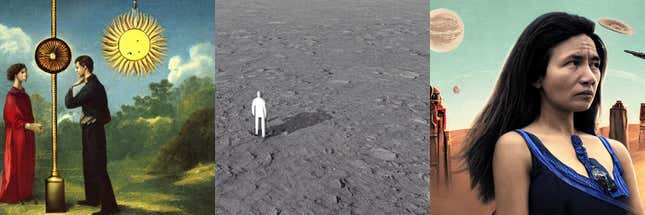
A lot’s been said about Stability AI’s free art generator while it was in closed beta, but on Aug. 22 the free image generator finally got a full release and since then it’s been one of the more talked about image creators. Stable Diffusion is open source, free, and unfiltered compared to the likes of Dall-E or Google’s (still publicly unavailable) Imagen. It’s basic page on Hugging Face is pretty rudimentary, but you can make it much easier to use with some simple freeware tools, though you’ll have to install Python to get it working. Stable Diffusion relies on a model based on the LAION-5B data set that filters out watermarked images and logos, according to its own page. Based on a report from tech blogger Andy Baio, many of the images are mostly sourced from Pinterest and other photo and art blogs. My attempts at asking it to create its own art without telling it to ape copy one particular artist were largely unsuccessful. It kept offering me black and white images without any kind of style or substance. Without asking it to copy a specific artist, it only offers pretty disappointing works compared to what other users have managed to get.
It seems the system is much better at coming up with art when you specifically ask it to do it in the style of a particular artist. This, of course, introduces a host of ethical problems especially for the living artists people may be emulating, as shown by fantasy artist Greg Rutkowski who was interviewed by MIT Technology Review and said he was worried the number of fake AI art bearing his name would eclipse his own visibility.
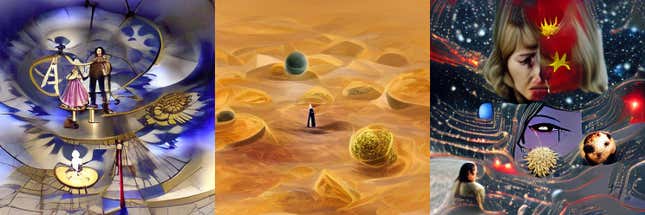
You got to love freeware, and this Python-based Google Colab notebook is relatively easy to use, so really, you have to give major props for a system that’s both relatively simple and open and available to all users. All you have to do is go to the link, scroll down and input your prompt in the text box, then either hit Ctrl+F9 or Runtime – Run All.
But of course we’re ranking system’s artistic ability. The system progressively iterates on the design, so you can see where the AI is trying to go with each image. My prompts offered some really interesting results but a few head scratchers as well.

I appreciate StarryAI’s clean interface and simple systems, though of course this is another one that gives users a few free credits to start before eventually asking you to cough up for more. Again, there’s nothing wrong with getting users to pay for creating a whole lot of art, but it does have to be worth it. This art generator also lets users upload an initial image to give the AI a leg up, but there’s no hand holding allowed here for these rankings.
The art itself is a mixed bag. I like what It came up with for The Dispossessed but can’t really tell what it had in mind for A Memory Called Empire.
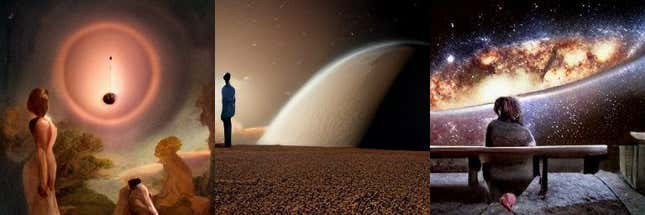
The system once known as Dall-E Mini, now Craiyon, creates a host of different images it hopes fits the bill, so I chose the closest out of all of them to the spirit of the prompt. The images themselves are pretty low resolution, which does detract from the fact it’s giving you so many options to choose from based on a single sentence.
Even when choosing among nine different tiles, the art left a lot to be desired. Compared to other AI art, craiyon really does feel like it’s grabbing images from all over the internet and turning them into a hodgepodge of an approximation of what it thinks is the prompt.

Google’s Deep Dream Generator claims it can transform images into stylized works of art. The main feed of images on the site does make it seem very evocative, but of course it’s not exactly easy to make an image of young Skip appear as more than just a dog with a Photoshop filter on.
I put young Skip in the style of Pieter Bruegel, the famed Dutch artist behind works like The Blind Leading the Blind. It came out… okay. I tried it with a mandala pattern and it was… interesting, I guess. I then added a Salvador Dali painting to the style, and—well—it came out kind of boring.
It’s definitely a fun tool, but it feels like I’m playing with a sophisticated color-in-the-lines book rather than generating any real art.

The Nightcafe system will only let you do a few images before asking you to pay up, but like some other AI image generators it gives users a whole selection of different styles to choose from. It wants users to buy “credits” in order to make more arts or bump up the quality and resolution of each image, and you will run out fairly quickly.
The art itself is all over the place. I appreciate what it tried to do with The Dispossessed but it wouldn’t even create a human-looking being in either of the other two prompts. The image resolution is also not great, and the art is very strange even in the default oil painting setting. Sure, it’s nice to be able to try out the system to see if you like it first, but even for just $10 a month, I can’t say you won’t find better options out there.
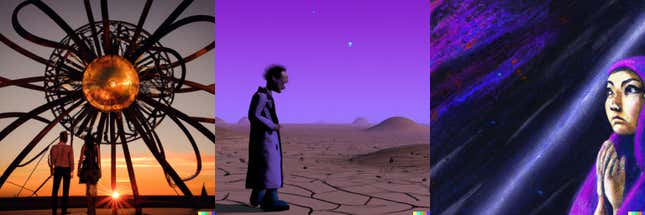
DALL-E 2 may have been the most hotly anticipated AI image generator since it was initially put into its beta release back in April. However, as shown by these examples there’s been multiple releases to cash in on the AI-art craze.
OpenAI, the makers of DALL-E, finally released their system to the wider public Sept. 28. Like many other systems, it offers users a slate of 50 free prompts, plus a few more each month. Users can also pay for more image generation credits.
My experiences with DALL-E have been interesting, to say the least. I find the system does not compute specific artists too well, and even when you give it pretty detailed instructions it defaults to an impressionistic art style. Of course, that’s not what this ranking is looking to do. For this, I’m more interested in what each AI system is capable on its own without giving it an image to specifically replicate. DALL-E’s systems obviously draw from a whole host of real photos and art, but it still largely fails to replicate faces. However, the generator did seem fond of the prompt for A Memory Called Empire and it offered several inspiring images that capture the essence of the book.
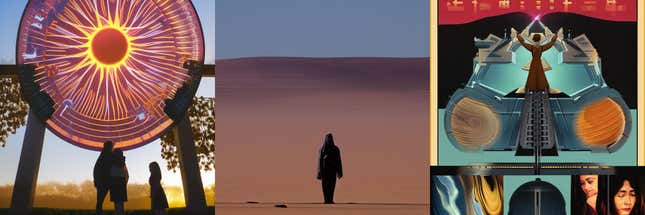
The sequel to the first Stable Diffusion, developed by Stability AI, may struggle to call itself a full iteration compared to its original incarnation, but the new system released in late November is certainly an upgrade in many ways from its predecessor.
In its announcement blog, Stability AI noted it had introduced a new text encoder which was developed by LAION, the open source project which also provided the massive image set that Stable Diffusion draws from. Stable Diffusion 2 also displays images at a much better resolution and is also better at upscaling them, according to Stability AI. They also mention it features a greater ability to facilitate depth of field, though in my own tests with my prompts that didn’t really come up.
When using the system to generate my open-ended prompts, I was surprised at the crispness of some of the generated images. I want the AI to generate images without mention of any particular artist, style, or format. Without prompting it to base a face on any one person, the system still struggles to generate a realistic head. Still, I was surprised what it came up with for my Under the Pendulum Sun prompt.
Strangely, every single time I fed Stable Diffusion 2 my A Memory Called Empire prompt, it came up with a comic-inspired display. I picked the best one, but it is especially concerning that the system wants to keep replicating text. It’s more evidence of how much the system has likely borrowed from scans of actual comics and comic artists.

The Wombo Dream system allows you to create art in multiple different styles such as old retro art, Salvador Dahli, or—simply—“Ghibli.” I chose a different style for each based on the style of each book. It also allows you to include a reference image that Dream can use, but I’ve restricted the system to its own imagination. You can also turn the images into NFTs, but thanks, no.
I have to hand it to Wombo, some of this art is truly evocative. I’m especially taken by the Throwback filter, as it definitely gave it the 1970s art style look you might see on an old album cover. Though as you can tell, it’s very loose with its interpretations. The weirdly erotic sense I get from its interpretation of A Memory Called Empire is strange since that wasn’t the prompt. I was very surprised by its interpretation of Under the Pendulum Sun, so it gets rather high marks.
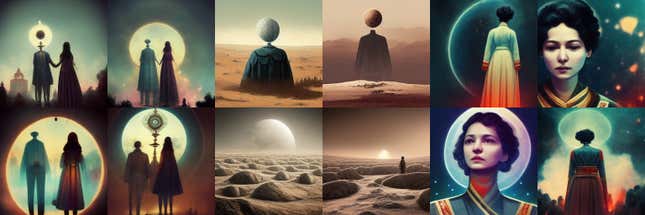
The crown of the AI art generation scene falls on none other than Midjourney. It’s gotten quite a lot of hype since its open beta first burst up from the weeds of Discord’s servers, but it’s honestly one of the best AI art generators available. Though I’ve seen some rather strange depictions of ships and other objects, the crispness of the generated images could convince somebody they were done with human hands.
I will say that Midjourney does have a little sense of repetition, as I’ve seen similar poses among the stoic, female design among other user-prompted images. However, that doesn’t take away from how evocative the art is, especially based on such strange, convoluted prompts. I mean just look at it! Several of the images based on The Dispossessed prompt could be the actual cover to the book. Several of those in the last panel are easily how I might imagine Mahit Dzmare from A Memory Called Empire would look like.
The program remains beholden to Discord, and the bot offers the first few generated images as a trial, then asks users to pay $10 for a monthly basic membership with 200 images.
Update, April 2023: Midjourney has grown so popular that its creator has stopped offering free trials, citing inability to meet demand. CEO Dave Holz told The Verge the discontinuation of the free version happened “because of massive amounts of people making throwaway accounts to get free images.” Though Midjourney’s website still lists free trials as an option, attempting to use the “/imagine” prompt to generate an image in the Midjourney Discord will return the message “Due to extreme demand we can’t provide a free trial right now. Please /subscribe or try again tomorrow.”
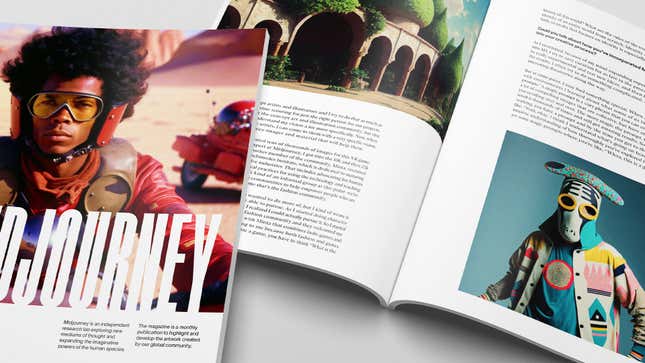
The company behind our favorite AI art generator is launching a monthly magazine. A subscription will cost you $4, though the company is offering copies of the first issue for free.
Why would a potential subscriber want to pay for print copies of free online images?
“We thought it would be fun, and the community agreed, so we did it,” Midjourney founder David Holz told Gizmodo.
More from Gizmodo’s story on Midjourney magazine:
The company behind the tool will feature images in its simply and uncreatively titled publication picked from among the 10,000 images rated highest by its site’s community members, according to its website. Interviews with image makers and Midjourney enthusiasts will also appear in the magazine. The Midjourney Community Showcase page displays images submitted and rated by users.
Want to know more about AI, chatbots, and the future of machine learning? Check out our full coverage of artificial intelligence, or browse our guides on How to Use ChatGPT and Everything We Know About the OpenAI chatbot.






